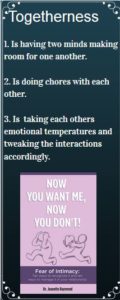Relationship Advice Tips from Dr. Jeanette Raymond, Ph.D.
Most couples I see in my therapy office say they want to feel like they are ‘on the same team’ and ‘on the same page’, but when we explore how they live their lives, there is very little sign of togetherness.
Three ways couples deprive themselves ‘togetherness’ and the emotional intimacy that it brings.
- Unhappy and emotionally distant couples usually divide up the jobs that need to get done, and want recognition for it. So they spend their times separate from one and other and only come together for the short moment to get a pat on the back.
- Couples who lack emotional closeness try to get their ideas and strategies for making life smooth onto the top of the list, without collaborating and making a joint list where they both have a valuable place.
- Couples who are not emotionally intimate expect their partners to either always be available and in the same emotional place or act as if they are on different planets, irritable and hungry for connection.
photograph copyright, Jeanette Raymond, Ph.D.
Togetherness is literally about thinking and doing things alongside one another – not instead of, for the person or to win brownie points.
Creating Togetherness
1. Do chores together.
In the journal Sex Roles, 2014, researchers found that doing chores together enhanced both physical and emotional intimacy because the feeling of togetherness promoted a more loving and welcoming place for the couple to relate.
2. Treasure your mind and that of your partner’s
Make room for your partner’s experiences, views and expectations. Just because they are different from yours, doesn’t mean they aren’t valid. In fact you can learn about how your partner tastes the world in a way that compliments yours. Be inclusive and enjoy the togetherness it brings.
3. Take your partner’s emotional temperature as often as you can – and allow them the same option
Sharing where you are at in the moment gives your partner an instant emotional GPS about how to approach you and at what pace. Same for you when you take time to check in and get real time information. Don’t rely on what you think or imagine because it’s tainted with old bad experiences and covers up the actual evidence in the moment. When you have an idea of where your partner is, and they have information about your emotional state, both of you adapt your journey towards one another, speeding up or slowing down according to the flow of traffic in the emotional lanes. That makes your efforts to connect more likely to be welcomed and for you to be in synch.
Listen to my interview with Dr. Michelle Cohen, Of LA Talk Radio here
AUTHOR OF ‘Now You Want Me, Now You Don’t! Fear of Intimacy: ten ways to recognize it and ten ways to manage it in your relationships.”
Copyright, Jeanette Raymond, Ph.D.
You might also like:
Top Three emotional intimacy problems
Rules about the roles partners should play, stops relationships from getting to first base
How to be equal partners in your marriage
Disclaimer: this article is for informational and educative purposes only. Dr. Raymond is not responsible for any reactions you may have when reading the content or using the suggestions therein. Interacting with this material does not constitute a therapeutic relationship with Dr. Jeanette Raymond


